Monopoly Game (Syndote)
Syndote is the name of a Monopoly-like decentralized game that works completely on-chain. It has no backend or any centralized components, the user interface interacts directly with the program uploaded in the Gear Network.
This is a "game strategies battle" where players compete with each other by implementing various playing strategies uploaded as programs into the network.
Syndote consists of Master program and Player programs. Master program is the main program that starts and controls the game. Player programs implement the game strategies that can be unique for each participant of the game.
After the game starts, all moves in the game take place automatically, but the UI provides an ability to jump to each one individually to analyze the player's strategy. To complete the game and determine the winner, many moves are required, which are processed over several blocks. In order for the Master program to have enough gas to perform all the moves, the gas reservation technology is used.
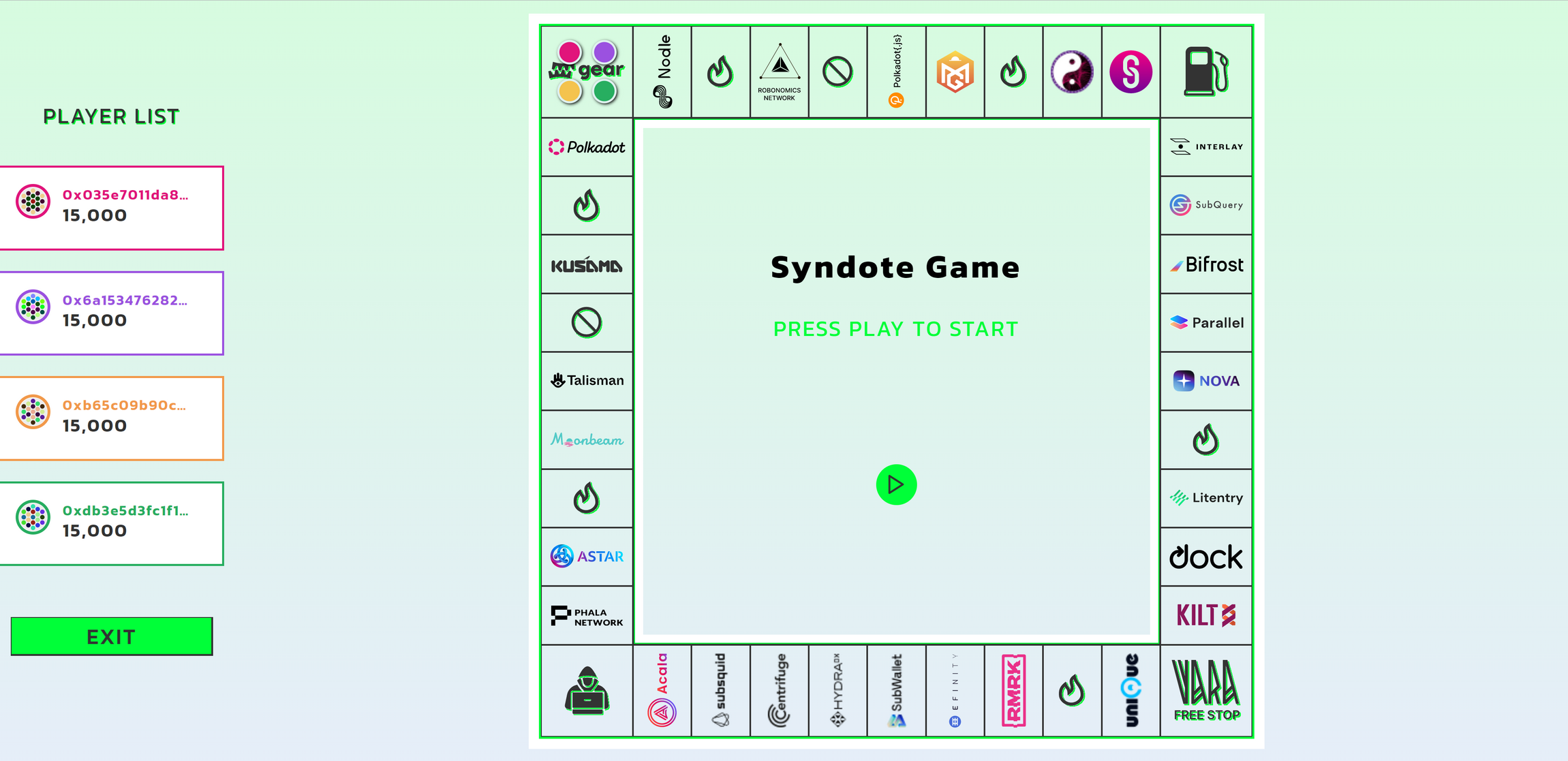
To launch the game, you need to:
- ⚒️ Build Master and Player programs
- 🏗️ Upload the programs to the network
- 🖥️ Build and run user interface
⚒️ Build Master and Player programs
- Get the source code of Master and Player programs from GitHub.
- Modify Player's program as you wish to achieve optimal game strategy.
- Build programs as described in program/README.md.
🏗️ Upload programs on chain
There are two ways to upload the game onto the chain:
- Using Gear IDEA portal;
- Using
gear-js/cli.
1. Using Gear IDEA portal:
- In the network selector, select the network where you’ll run the game:
- Vara Network Testnet - wss://testnet.vara.network;
- Local node - ws://localhost:9944
- Upload Master and Player programs:
- Click the
Upload Programbutton and specifyx.opt.wasmfile of the program, also specify the*.txtfile with metadata for Master and Palyer programs accordingly. - Save the addresses of the uploaded programs.
- Click the
- Make gas reservations to ensure continuous game execution.
- Find your uploaded Master program and click the
Send messagebutton: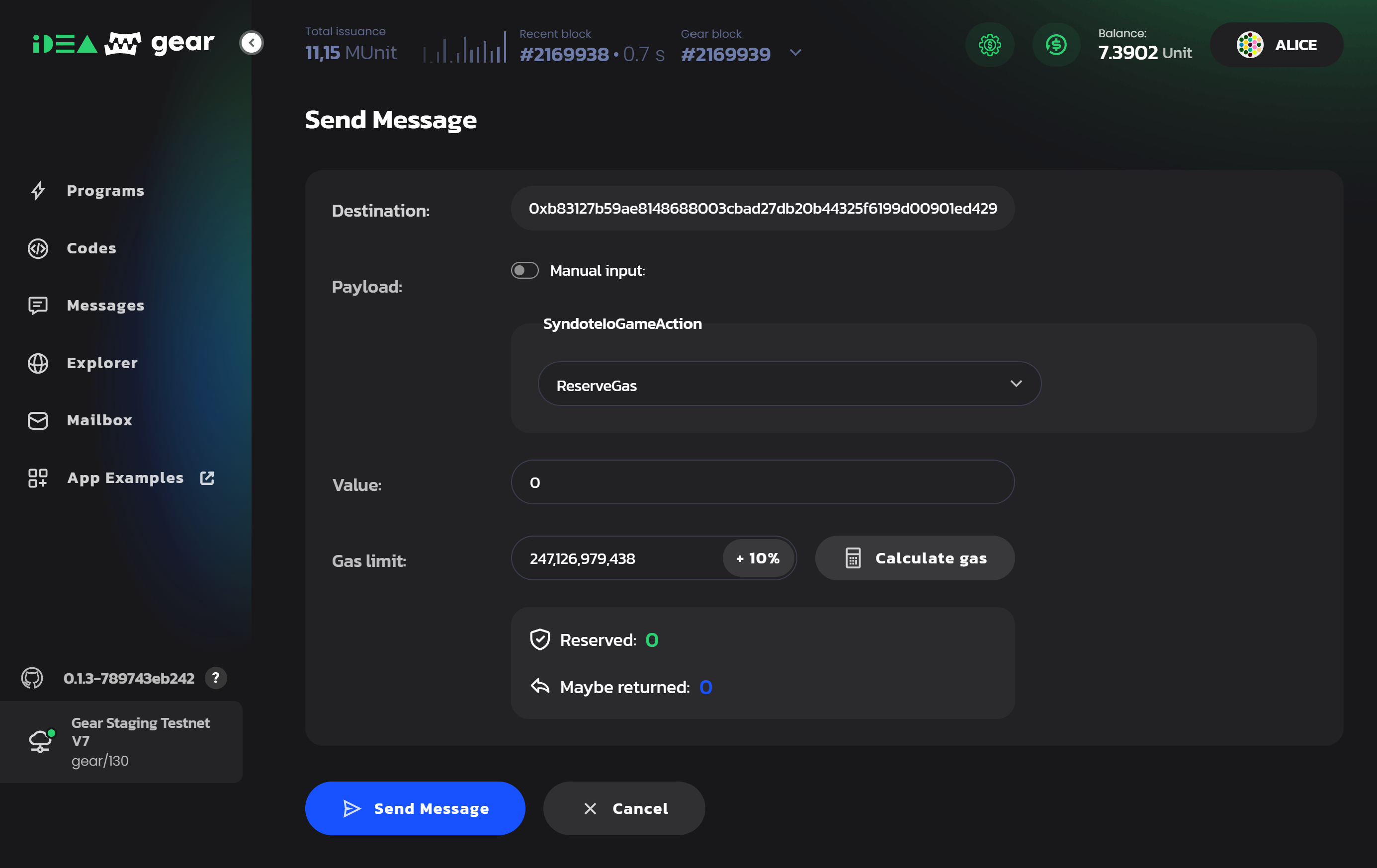
- Currently, the single gas reservation amount can be up to 245 000 000 000 since it is not yet possible to make a reservation more than the block gas limit (250 000 000 000). It is recommended to make at least 5-10 reservations to make sure the Master program has enough gas to run and complete the game.
- Find your uploaded Master program and click the
2. Using gear-js/cli
It allows sending transactions to the Gear node based on yaml file:
-
Go to folder with scripts:
cd ./syndote-upload-game/ -
Upload previously built files into
/programsfolder (replace if necessary):player.meta.txt,syndote.meta.txt,player.opt.wasm,syndote.opt.wasm -
Install
gear-js/cli:npm install -g @gear-js/cli -
Upload the master program. The
upload-game.yamlfile contains a transaction that will deploy the program onto the network, check README for more details. -
Customize the following parameters:
- Specify the accounts using on of these methods - mnemonic phrase, seed or Using well-known account such as
AliceandBob
accounts:
alice: 'bottom drive obey lake curtain smoke basket hold race lonely fit walk'
bob: //Bob
my_account: '0x…seed'
transactions:
account: alice- You can also specify which node you want to deploy the program on by defining the variable
wsAddressin the file with transactions. If this variable is not defined, the program will be deployed on the local node which should be running beforehand:wsAddress: wss://testnet.vara.network
- Specify the accounts using on of these methods - mnemonic phrase, seed or Using well-known account such as
-
To deploy the program, run the command:
gear-js workflow upload-game.yaml -
If everything goes well, you will see the program address in the terminal:

-
To run the application, it is necessary to save this address and later specify it as a variable in the
.envfile. -
Make gas reservations to ensure continuous game execution. Open
reserve-gas.yamlfile and customize account and node address as described above. Run the command with the master program address specified:gear-js workflow reserve-gas.yaml -a program_id='0x60663aaee2971eb60874b63c92e738cc375f3764a1d3b38d65cbc63d8ee8f70c' -
If everything goes well, you will see a message confirming a successful reservation. Please send this message 5-10 times to ensure uninterrupted gameplay.

-
Upload players programs to the network. For testing purposes, you can upload 4 identical player programs. After initialization in the network, their addresses will be unique and you will then need to register them in the game. Open
players.yamlfile and customize account and node address as described above. Run the command to add players in the game:gear-js workflow players.yaml -
You will see the players addresses:
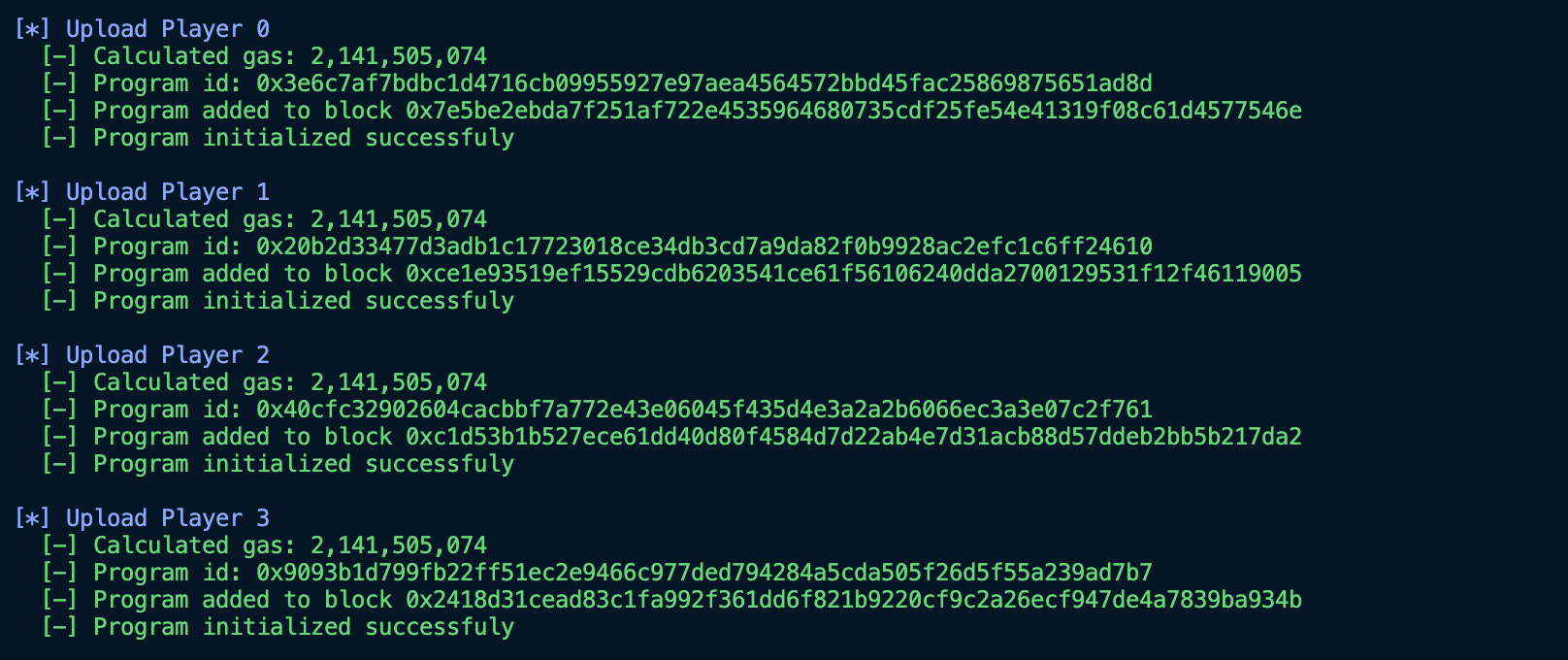
-
Additionally, you can write your own player program, build it, and place the
.opt.wasmand.meta.txtfiles into theupload-game/programsfolder. To deploy your player, specify the necessary files in theplayers.yamlfile instead of any existing player.
🖥️ Build and run user interface
- Download this repository locally and go to the
frontendfolder. - Install packages:
yarn install
- Declare environment variables, go to
/frontend/foler, create new.envfile, check.env.examplefile to get necessary variables:REACT_APP_SYNDOTE_NODE_ADDRESS- in this parameter specify the address of the node on which you deployed the programs.REACT_APP_CONTRACT_ADDRESS- in this parameter specify the address of the deployed master program.
- Put the latest version of the
syndote.meta.txtfile locally insrc/assets/wasm/folder, replace if necessary.
In order for all features to work as expected, the node and its runtime version should be chosen based on the current @gear-js/api version. In case of issues with the application, try to switch to another network or run your own local node and specify its address in the .env file. When applicable, make sure the program(s) wasm files are uploaded and running in this network accordingly.
Also, you can try npm i --force in case of yarn install issues.
- Run the app:
yarn start
Run the game
-
Find the players addresses you have prevously uploaded.
-
Register players in the application's interface one after another. Each player registration is a transaction that needs to be signed. It is possible to register up to 4 players.
-
Once everything is done, start the game via the
Playbutton. You will see the game result almost instantly. Click<and>buttons to navigate through the game and check each separate move.
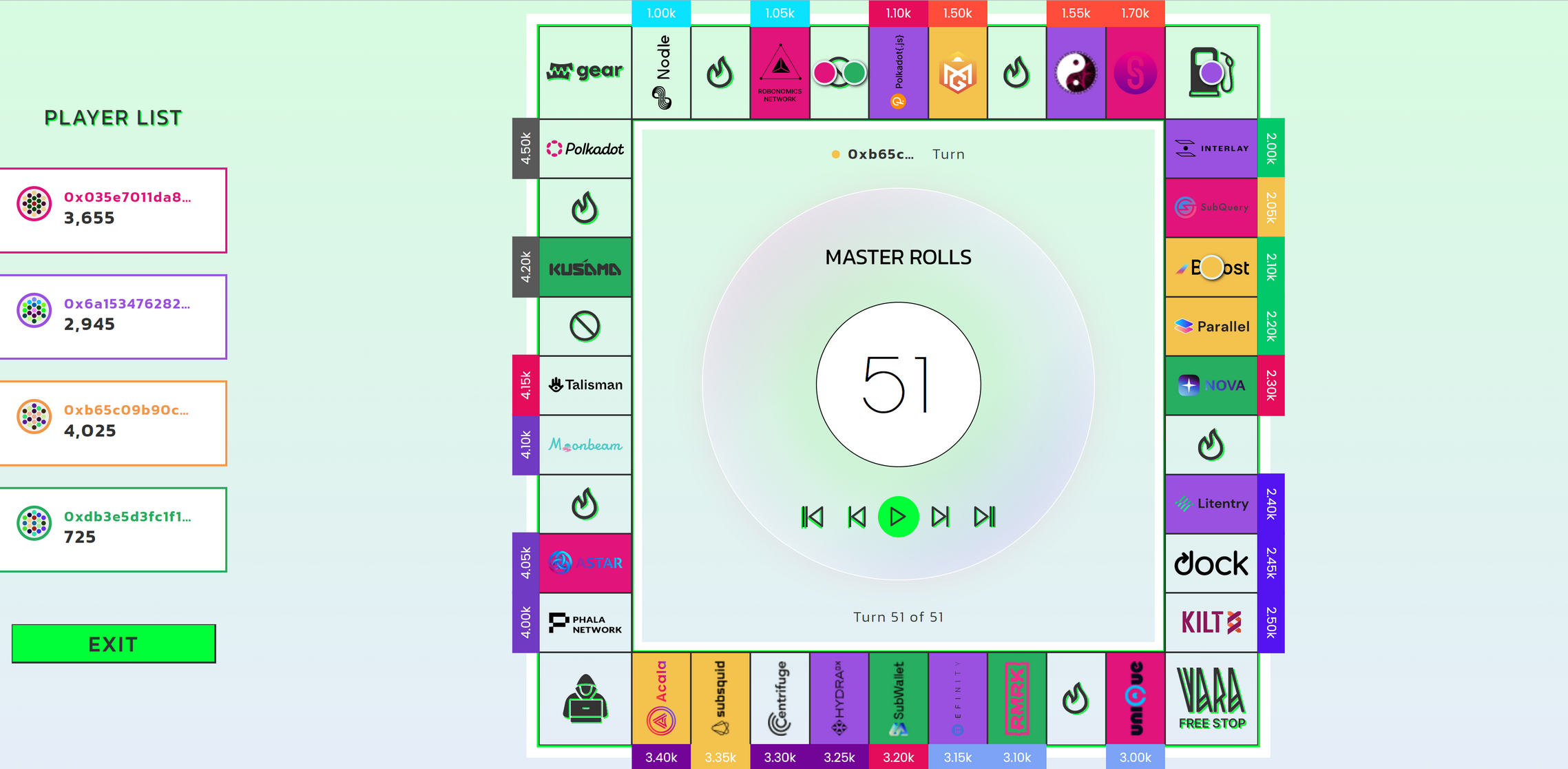
- If the game is not over, make more reservations and send a message
GameAction::Playagain. After the game is over, it's state becomes Finished and the admin can restart the game by starting a new player registration.
Programs
Master program
The Master program initiates with monopoly card details (cell cost, special cells like jail and lottery) and is preloaded with sufficient gas for automated play. Prior to each player's move, the master program verifies the gas amount, triggering a message to the game admin for additional gas reservation if needed.
Players registration:
Players deploy their strategic programs and send a message Register to Master program. Master program:
- Adds the players the list of participants and initializes it with the following structure:
struct PlayerInfo {
position: 0,
balance: 15000,
debt: 0,
in_jail: false,
round: 0,
cells: BTreeSet::new(),
penalty: 0,
lost: false,
}
- If the number of participants is 4,
Masterprogram goes to the state of waiting for the start of the game.
When the required number of participants is reached, the admin sends a message Play to Master program. This message starts an automated game that will scroll through the algorithms of the participants in turn:
Masterprogram starts the round. Each round contains 4 steps (Each player makes one step). Before each stepMasterprogram checks the states of the participants (whether they are bankrupt or may be there is already a winner);- Each step contains the interaction with the strategic program in turn:
- If the number of steps in the current round is 4,
Masterprogram starts the following round.
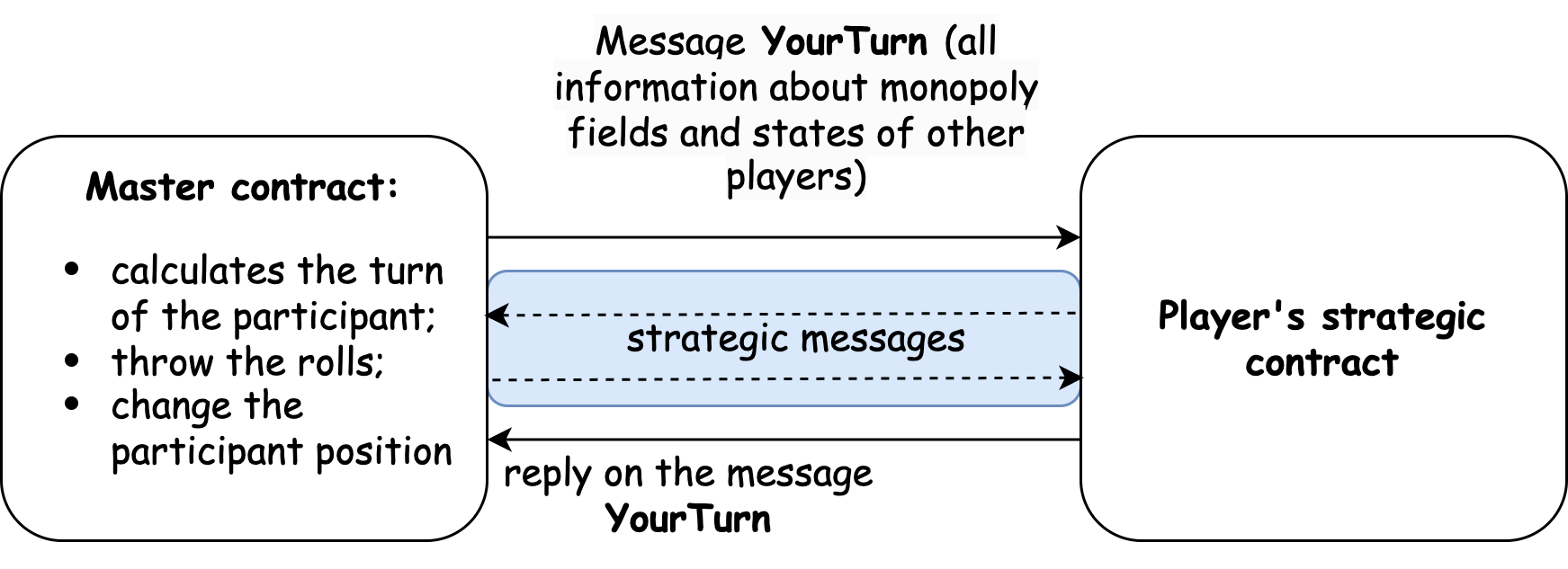
Strategic messages: Strategic programs send strategic messages depending on the position on the monopoly field. A player may be in one of the following positions:
-
A cell with his own property. A player has a right:
- To add a gear on the cell. The gear can be
Bronze,SilverorGold; - To upgrade a gear (from
BronzetoSilverand fromSilvertoGold);
- To add a gear on the cell. The gear can be
-
Do nothing. During actions
AddGearandUpgradea player can sell his other properties to the bank if he does not have enough balance. -
A cell with other properties. A player has to pay rent. If he has not enough balance, he can sell his properties to the bank. Otherwise he is declared bankrupt.
-
Sell with properties which no one has bought yet. A player has a right:
- Buy cell (with option to sell properties to the bank if not enough balance);
- Do nothing.
-
Jail. A player can throw the rolls. If it is double he gets out of the jail and his position is moved for the roll sum. If it is not a double a player can pay a fine or wait for the next round to throw the rolls again.
-
Empty cells. In the
Masterprogram there are cells that are not filled with anything. The developers themselves can expand the functionality of the game and add different game mechanics.
Player's program
Player is a program in which the monopoly game strategy is implemented. It must meet the following requirements:
- It has to accept the following message from
Masterprogram:That struct contains the information about the state of all players and about the monopoly fields and built gears.syndote/io/src/lib.rspub struct YourTurn {
pub players: Vec<(ActorId, PlayerInfo)>,
pub properties: Vec<Option<(ActorId, Gears, Price, Rent)>>,
} - Based on the information received, the strategic program has to make a move (
BuyCell,AddGear,Upgrade,PayRent,ThrowRollsetc). The move must be the asynchronous message to the monopoly program. - The move has to be made correctly. For example, if a player is in an already occupied field and tries to buy it, then
Masterprogram will fine him. Each wrong step is penalized with one point. If a player scores 5 penalty points, it is out of the game. - After the step a player has to send a reply to the monopoly program. This way the monopoly program knows about the completion of the step. The reply can be a simple empty message.
- If a player's program doesn’t reply,
Masterprogram will remove that player from the game. Masterprogram gives a limited amount of gas per turn. That amount is quite enough for the move, but if the player's program contains an incorrect logic (for example, an infinite loop), it will be removed from the game.